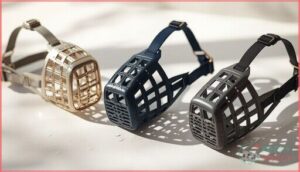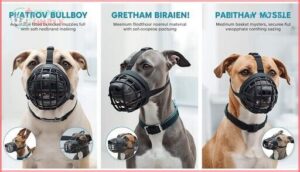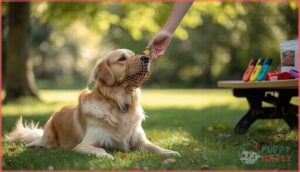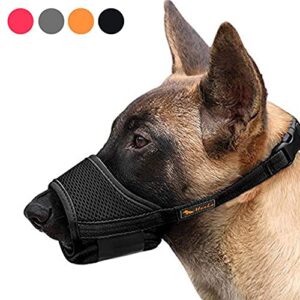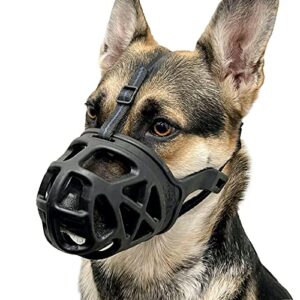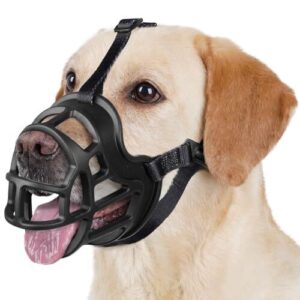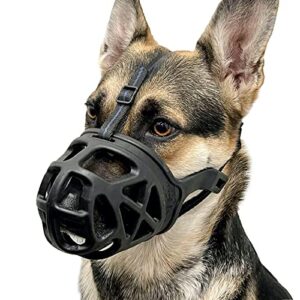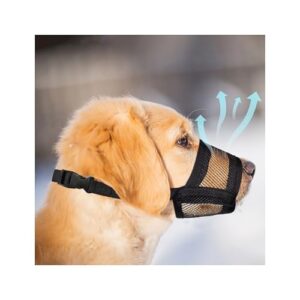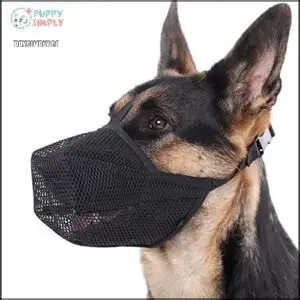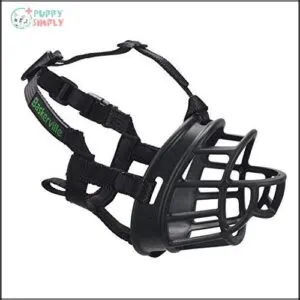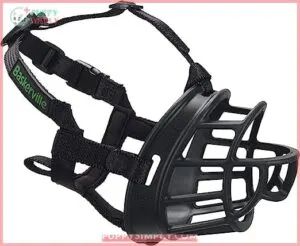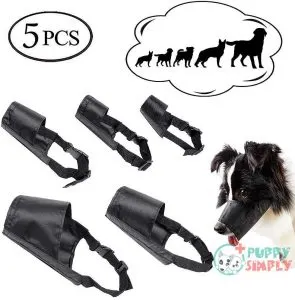This site is supported by our readers. We may earn a commission, at no cost to you, if you purchase through links.
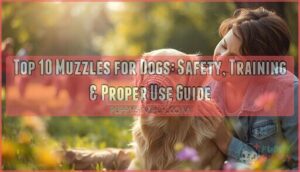
A dog wearing a muzzle isn’t automatically dangerous—in fact, nearly half of muzzled dogs wear them for legal compliance or prevention, not because they’ve ever bitten anyone. These misunderstood tools help dogs recovering from surgery avoid licking their wounds, support anxious pups through stressful vet visits, and give reactive dogs the freedom to explore the world safely.
When properly fitted and introduced through positive training, a muzzle becomes a passport to experiences that might otherwise be off-limits. The key lies in choosing the right type for your dog’s specific needs, whether that’s a breathable basket muzzle for extended wear or a soft fabric option for quick grooming sessions.
Understanding proper muzzle use protects both your dog and the people around them while building confidence instead of fear.
Table Of Contents
- Key Takeaways
- Removing The Stigma Around Dog Muzzles
- Appropriate Uses for Dog Muzzles
- When Not to Use a Dog Muzzle
- Types of Dog Muzzles Explained
- How to Train Your Dog to Wear a Muzzle
- Sizing and Fitting a Dog Muzzle
- Maintaining and Caring for Dog Muzzles
- Safety Precautions and Owner Responsibilities
- Top 10 Dog Muzzles for Safety and Comfort
- 1. Stress Free Pet Care Guide
- 2. Breathable Dog Muzzle For Safety
- 3. Humane Dog Muzzle For Large Breeds
- 4. Soft Dog Muzzle For Safety
- 5. Barkless Dog Muzzle Basket Black
- 6. Evollax Mesh Dog Muzzle Large Dogs
- 7. Mayerzon Soft Mesh Dog Muzzle
- 8. Baskerville Ultra Dog Muzzle Size 5
- 9. Baskerville Ultra Dog Muzzle Size 4
- 10. Adjustable Breathable Dog Muzzle Set
- Frequently Asked Questions (FAQs)
- How can I tell if my dog is stressed or uncomfortable while wearing a muzzle?
- What should I do if my dog tries to remove the muzzle?
- How do I introduce my dog to other dogs while it’s wearing a muzzle?
- Can dogs drink water while wearing muzzles?
- How long can a dog safely wear a muzzle?
- Do muzzles help with excessive barking problems?
- Are muzzles safe for brachycephalic breeds?
- What materials are hypoallergenic for sensitive dogs?
- Conclusion
Key Takeaways
- Muzzles are safety tools, not punishment devices—nearly half of muzzled dogs wear them for legal compliance or prevention rather than past aggression, and they enable anxious or reactive dogs to safely explore the world when properly fitted and introduced through positive reinforcement training.
- Basket muzzles are superior for extended wear because they allow unrestricted panting, drinking, and breathing, while soft fabric muzzles restrict these essential functions and should only be used for brief, supervised periods under 15 minutes to prevent overheating and distress.
- Proper fit is critical for both safety and comfort—measure your dog’s snout length, circumference, and width carefully, ensure two-finger spacing under straps, and watch for warning signs like pressure marks, excessive pawing, or restricted panting that indicate the muzzle needs adjustment or replacement.
- Never use muzzles as behavior modification tools or leave dogs unsupervised while muzzled, since this can worsen anxiety, cause physical harm like skin wounds or overheating, and fail to address underlying issues that require professional training and positive reinforcement techniques.
Removing The Stigma Around Dog Muzzles
Many people see a muzzled dog and immediately think “dangerous,” but that couldn’t be further from the truth. Muzzles are safety tools that help dogs navigate the world more confidently, whether they’re recovering from an injury, working through anxiety, or simply need protection during vet visits.
Let’s clear up some common myths and explore how muzzles can actually improve your dog’s quality of life.
Common Misconceptions About Muzzle Use
When you see a muzzled dog, you might assume they’ve bitten someone before, but that’s rarely true. About 48% of muzzled dogs wear them only for legal compliance or prevention, not past aggression. Many people wrongly believe muzzles mean danger, but they’re actually safety tools for vet visits, public transport, or preventing scavenging.
Proper muzzle education helps shift public perception from fear to understanding. By learning about muzzle training techniques, owners can better understand the benefits of using muzzles.
Promoting Positive Muzzle Experiences
Your dog’s muzzle introduction sets the tone for their entire relationship with this pet safety tool. Using positive reinforcement during muzzle training helps your dog see it as something good, not scary. Dogs trained with treats and praise show markedly less barking and whining than those forced into muzzles. Proper muzzle training techniques are essential for a dog’s comfort and safety.
Three ways to promote muzzle acceptance and dog wellbeing:
- Start with high-value treats – Reward every calm interaction with the muzzle to build canine comfort naturally
- Keep sessions short and happy – Five-minute training periods prevent frustration and support dog behavior modification
- Practice in fun environments – Introduce muzzle safety during playtime or after walks when your dog’s already relaxed
Muzzles as Tools for Safety and Welfare
Think of dog muzzles as seat belts for your pup—they’re about protection, not punishment. When you choose proper muzzle materials and muzzle design, you’re prioritizing canine welfare and pet safety.
Dog muzzles are seat belts for your pup—they’re about protection, not punishment
Basket-style options let your dog pant, drink, and breathe comfortably, meeting safety regulations while supporting animal protection.
A well-fitted dog muzzle protects everyone without compromising dog safety or canine behavior—that’s responsible animal welfare in action.
Appropriate Uses for Dog Muzzles
Understanding when and why to use a muzzle helps you keep your dog safe while respecting their needs. Muzzles aren’t just for “problem dogs”—they’re practical tools for everyday situations where an extra layer of protection makes sense.
Let’s look at the most common scenarios where a well-fitted muzzle can make all the difference.
Preventing Dog Bites and Aggression
Nearly half of all owners turn to muzzles specifically to prevent dog bite incidents in high-risk moments. When you’re managing aggressive dogs or working through behavior modification, a dog muzzle acts as your safety net during dog training sessions.
Studies show up to 50% fewer bite incidents in busy areas where muzzle effectiveness is paired with positive reinforcement, proving that aggression management tools work when regulatory frameworks and proper conditioning come together.
Safe Socialization and Public Outings
Public transport, crowded parks, and busy sidewalks become manageable when you combine a dog muzzle with solid leash training and behavior modification. Research shows 37% of owners notice communication challenges during dog-to-dog encounters, but proper crowd control strategies balance pet safety with social etiquette.
You’re protecting your dog and others while teaching aggressive dogs healthier responses in high-stimulus public interactions.
Veterinary Visits and Grooming Sessions
Veterinary care and grooming sessions present moments when even the gentlest dog might react out of fear or discomfort. About 31% of owners report calmer behavior during vet visits when using basket muzzles, protecting both your pet and the professionals handling them.
- Muzzle safety reduces staff bite risk during invasive procedures like blood draws or nail trimming
- Veterinarian confidence improves, allowing thorough examinations without rushed restraint
- Canine stress decreases with gradual muzzle training using treats before appointments
- Pet wellness stays priority—proper fit ensures breathing and panting during longer grooming sessions
Emergency Situations and First Aid
Panic can trigger defensive biting even in friendly dogs when they’re injured or frightened. During emergency situations, temporary muzzling reduces human injury risk by 88% while providing first aid.
You’ll find improvised muzzles using gauze work effectively in 73% of crisis management cases, though brachycephalic breeds need special caution. Never leave a muzzle on longer than 10 minutes during emergency response—canine safety requires proper breathing access throughout pet safety interventions.
When Not to Use a Dog Muzzle
While muzzles are valuable safety tools, they aren’t appropriate for every situation. Using a muzzle at the wrong time or for the wrong reasons can actually make behavioral issues worse and put your dog’s health at risk.
Let’s look at three situations where you shouldn’t reach for a muzzle.
Addressing Behavioral Problems
Think of a muzzle as a safety barrier, not a behavior fix. If your dog struggles with excessive barking, destructive chewing, or emotional distress, muzzle misuse won’t get to the bottom of the problem and may actually increase anxiety triggers.
You need proper dog behavior modification through structured training alternatives and professional guidance instead. Experts emphasize that muzzles manage physical safety during canine behavior modification, but they’re no substitute for resolving underlying behavioral issues through thorough dog training and behavior programs.
Risks of Using Muzzles for Punishment
Using a muzzle as punishment can backfire in ways that harm your dog’s welfare impact long-term. Nearly 20% of owners noticed behavioral consequences like anxiety and withdrawal when dog muzzle usage turned punitive, and 12.9% saw physical health issues, including skin damage.
Expert guidelines are clear: muzzles aren’t behavior modification tools. Punishment-based dog training and behavior methods erode trust, worsen social barriers, and can even increase dog bite risk.
Dangers of Unsupervised Muzzle Wear
Leaving your dog muzzled without supervision creates serious pet safety and welfare risks. Even short unsupervised periods can trigger physical harm and behavioral impacts that compromise your dog’s health.
Watch for these critical dangers:
- Thermoregulation risks and hydration issues – 14.9% of owners reported overheating, especially with fabric muzzles that restrict panting
- Chafing hazards – 34.7% documented skin wounds from extended wear
- Communication compromise – 19.6% saw anxiety and withdrawal affecting dog behavior management
Types of Dog Muzzles Explained
Not all muzzles are created equal, and choosing the right one depends on your dog’s needs and the situation you’re preparing for. Some designs prioritize breathability and long-term wear, while others are meant for short-term use or emergencies.
Let’s break down the main types so you can make an informed decision that keeps your dog safe and comfortable.
Basket Muzzles: Materials and Benefits
Basket muzzles offer your dog the best combination of safety and comfort. Made from wire, BioThane, hard plastic, or leather, these designs allow panting freedom and drinking—critical for preventing overheating.
Wire and plastic models provide maximum bite prevention while supporting training integration with treat rewards.
Studies show 98% effectiveness in injury prevention, and proper basket muzzle use creates minimal welfare impact, letting your dog breathe naturally while staying secure.
Soft and Fabric Muzzles
Unlike basket designs, soft and fabric muzzles hold your dog’s mouth closed using lightweight nylon or breathable mesh. You’ll find these used in 66% of stressful vet or grooming visits because they’re quick to apply.
However, they restrict panting in 94% of cases, risking overheating. Veterinary guidelines recommend limiting use to under 15 minutes—they’re emergency tools, not long-term solutions for muzzle training or pet care.
Custom-Fitted and Breed-Specific Muzzles
For breeds with unique facial structures—like short-nosed Bulldogs or long-snouted Greyhounds—custom designs offer precise fit technology that standard muzzles can’t match. As of 2025, customised listings for breed-specific dog equipment now include 13 standard sizes, with options spanning snouts from 5/8 to 5.5 inches.
Key advantages of custom dog muzzles:
- Muzzle materials like biothane with neoprene nose pieces prevent chafing
- Breed standards addressed through adjustable safety features and top-of-head straps
- Dog muzzles fit that allows eating, drinking, and unrestricted panting
Emergency and Homemade Muzzles
When commercial options aren’t available—say, after an accident or sudden injury—you’ll need a temporary solution. Veterinary manuals recommend keeping gauze, cloth strips, or leashes in your pet emergency kit. These homemade muzzle materials work for immediate safety during first aid, but they’re not substitutes for proper basket muzzle or soft muzzle designs meant for longer wear.
Homemade designs restrict panting, so emergency preparedness for pets means knowing when to remove temporary solutions immediately—especially in warm conditions or if your dog shows distress.
| Material | Best Emergency Use | Safety Precautions |
|---|---|---|
| Gauze (doubled) | Wound treatment, transport | Remove every 10–15 minutes |
| Cloth strips | Accident response, first aid | Never use on brachycephalic breeds |
| Leashes/rope | Temporary restraint | Must allow breathing, quick removal |
| Bandages | Veterinary emergencies | Contraindicated if vomiting occurs |
How to Train Your Dog to Wear a Muzzle
Training your dog to wear a muzzle doesn’t have to be a battle—it’s all about taking small steps and making the experience rewarding. Using food rewards and patience can turn what seems like a stressful task into something your dog actually accepts, or even enjoys.
Let’s walk through the key techniques that make muzzle training easier for both you and your dog.
Positive Reinforcement Techniques
Training your dog to wear a muzzle works best through reward-based training and operant conditioning. Start by placing high-value treats near or inside the muzzle, creating a classical association between the equipment and positive experiences. Mark each voluntary acceptance with a clicker and immediate reward.
This muzzle desensitization approach, rooted in proven animal training methods, builds genuine comfort rather than forced compliance during muzzle training.
Reducing Anxiety and Avoidance Behaviors
When dogs freeze, paw at the muzzle, or refuse treats, they’re showing stress that demands your attention. Gradual introduction through muzzle desensitization confronts these avoidance behaviors directly.
By prioritizing comfort and building positive associations with training consistency, you’ll see anxious responses fade. Dogs trained with patience during muzzle training and safety protocols show markedly less distress, supporting better dog behavior and overall animal training outcomes for dog wellbeing.
Sizing and Fitting a Dog Muzzle
Getting the right fit for your dog’s muzzle isn’t just about comfort—it’s about safety and effectiveness. A poorly fitted muzzle can cause physical discomfort, restrict breathing, or allow your dog to slip free when you need it most.
Let’s walk through the key steps to measure, fit, and adjust a muzzle so it works the way it should.
Measuring Your Dog’s Snout
Getting accurate measurements is the foundation of proper muzzle sizing. You’ll need three key measurements to find the right fit for your dog:
- Snout Length: Measure from your dog’s nose tip to about half an inch below the eyes along the bridge—don’t curve the tape
- Snout Circumference: Wrap the tape snugly (not tight) around the widest part, half an inch below the eye line
- Snout Width and Height: Capture the widest horizontal point and vertical distance at the measurement line
Breed measurement charts provide helpful starting points, but individual variation means you can’t skip measuring your specific dog. Even within breeds like Golden Retrievers or German Shepherds, snout dimensions vary enough that relying solely on breed recommendations leads to poor muzzle selection in over 20% of cases.
For accurate fitting and ideal dog muzzle design, take all three measurements with your dog’s mouth closed and standing calmly.
Importance of Proper Fit for Comfort
A poorly fitted muzzle transforms a safety tool into a source of suffering. Your dog needs room to pant fully—that’s how they cool down and breathe comfortably.
Proper Muzzle Sizing prevents the 12.9% risk of physical injuries like pressure marks and broken fur.
Follow Fit Guidelines requiring half an inch of space at the nose, ensuring Breathability Tests confirm your dog can open their mouth while the Snout Circumference measurement accommodates natural movement without restriction.
Adjusting Straps and Ensuring Safety
Think of strap adjustment as the final lock on your safety system—without it, even the best muzzle fails. Secure fitting protects both your dog and others, preventing escape and injury.
- Strap Adjustment: Slide only one to two fingers between the strap and your dog’s head for proper tension
- Muzzle Safety: Position straps beneath ears with longer material under the jaw for stability
- Escape Prevention: Buckle first, then incrementally tighten using the loose end
- Biothane Straps: Choose water-resistant, hypoallergenic materials that maintain strength
- Muzzle Maintenance: Regularly inspect strap tightness, especially after cleaning or reshaping
Signs of Poor Fit and How to Correct
When your dog freezes, paws at their face, or pants excessively, something’s wrong. These behavioral signs indicate that the fit needs immediate correction—44% of dogs with poor-fitting muzzles develop pressure sores or broken hair.
Proper dog muzzle selection and adjustment prevents these problems entirely.
| Sign of Poor Fit | Corrective Action |
|---|---|
| Pressure sores, red marks | Add padded inserts; remeasure snout |
| Panting restriction, overheating | Switch to basket style; verify two-finger spacing |
| Slipping hazards, escape attempts | Tighten straps; verify back width measurement |
| Drinking issues, treat refusal | Choose open-design muzzle; recheck circumference |
Maintaining and Caring for Dog Muzzles
A muzzle that’s worn regularly needs proper care to stay safe and effective. Without routine maintenance, materials can degrade, straps can weaken, and bacteria can build up—all of which compromise your dog’s comfort and protection.
Here’s how to keep your dog’s muzzle in top condition so it continues to work when you need it most.
Cleaning and Disinfecting Materials
A clean muzzle protects your dog’s health and keeps hygiene practices on point. Regular cleaning solutions and proper muzzle sanitizing matter for both material safety and animal welfare. Here’s your essential care routine:
- After each use: Rinse with warm water to remove saliva and debris
- Weekly: Scrub gently using mild, pet-safe soap
- Monthly: Apply safe disinfectant types like Accelerated Hydrogen Peroxide, ensuring dog equipment stays bacteria-free
Inspecting for Wear and Tear
After you’ve cleaned your dog muzzle, muzzle inspection becomes your next priority. Check weekly for broken straps, cracks in plastic, or frayed edges on leather muzzles and wire muzzles.
These safety checks catch wear detection early, preventing muzzle failure when you need it most. Replace any dog equipment showing damage immediately—material durability matters for tear prevention and your dog’s protection.
Storage Tips for Longevity
Once your muzzle passes inspection, proper storage solutions protect your investment. Keep your dog muzzle in a cool, dry spot away from sunlight—heat warps plastic and cracks leather.
Hang it on a dedicated hook or store flat in a drawer to maintain shape. This simple material care extends longevity and keeps your pet care products ready when dog health and safety matter most.
Safety Precautions and Owner Responsibilities
Using a muzzle isn’t a set-it-and-forget-it solution—it comes with real responsibilities that you need to take seriously. From keeping a close eye on your dog’s comfort to understanding the laws in your area, these safety measures protect both your pet and the people around you.
Let’s break down the key precautions every muzzle-wearing dog owner should follow.
Supervising Dogs While Muzzled
Think of your muzzled dog like a swimmer—you wouldn’t leave them unattended in deep water. The American Kennel Club emphasizes that dog muzzles are temporary tools requiring constant supervision. Without proper oversight, dog owners risk missing critical signs of distress, overheating, or improper fit that can quickly compromise dog health and animal welfare and behavior.
Here are essential Muzzle Safety Tips for Supervised Training:
- Watch canine body language closely—freezing, excessive pawing, or rubbing signals discomfort that demands immediate attention and potential muzzle removal techniques.
- Take frequent breaks—remove the muzzle every 30-60 minutes to assess comfort, allow drinking, and prevent pressure sores that affect nearly 9% of cases.
- Check the fit repeatedly—verify your dog can pant freely for proper thermoregulation, as restricted breathing poses serious risks during unsupervised moments.
Dog stress management starts with you staying present and responsive throughout every muzzled session.
Monitoring for Physical and Behavioral Effects
How often do you check for trouble signs once the muzzle is on? Research shows that 12.9% of dogs experience physical damage, such as pressure marks or fur loss, while nearly 20% exhibit behavioral changes, including anxiety or distress. Your vigilance is crucial in protecting your dog’s welfare.
Proper muzzle fit and training significantly impact these outcomes. Dogs wearing ill-fitting muzzles face considerably higher risks. Incorporating food rewards during the introduction of the muzzle can substantially reduce avoidance behaviors. It is essential to check your dog’s comfort every 15-20 minutes, especially during initial sessions, and make immediate adjustments if any distress signals are noticed.
| Warning Sign | What to Look For |
|---|---|
| Physical Damage | Broken hair, skin wounds, alopecia, pressure marks on snout or face |
| Behavioral Changes | Freezing, excessive pawing, rubbing nose on objects, nervousness |
| Thermoregulation Issues | Inability to pant fully, excessive drooling, signs of overheating |
By staying attentive and responsive to your dog’s needs, you can ensure their safety and well-being while using a muzzle.
Ensuring Dogs Can Breathe and Pant
Your dog’s life depends on unrestricted airflow when wearing a muzzle. Basket muzzles allow open-mouthed panting, while soft or fabric designs restrict this critical cooling mechanism. Veterinarians consistently recommend models that support full respiratory function, especially during warm weather or exercise.
Key considerations for breathing safety:
- Choose basket muzzle designs with wide openings that permit complete panting and drinking
- Avoid fabric muzzles for any activity lasting beyond a few supervised minutes
- Monitor for respiratory distress signs: excessive drooling, agitation, or unusual breathing sounds
- Select breed-specific muzzles for flat-faced dogs like Bulldogs who need extra airflow design
- Check that your dog can fully open their mouth inside the muzzle movement space
Proper muzzle ventilation isn’t optional—it’s essential canine safety equipment that prevents overheating and distress.
Legal Requirements and Public Regulations
In 1,200+ U.S. jurisdictions, breed restrictions target specific dogs for mandatory muzzling—pit bulls lead at 96%, followed by rottweilers and shepherds.
European countries enforce stricter public safety measures: Ireland fines non-compliant owners, while France requires muzzles for dogs over 6kg on transport.
Check your local animal control regulations before venturing out—responsible pet ownership means understanding enforcement policies that protect both your dog and community welfare.
Top 10 Dog Muzzles for Safety and Comfort
Choosing the right muzzle can feel overwhelming when you’re faced with countless options, but the best choice depends on your dog’s specific needs and temperament. Whether you need a muzzle for vet visits, training sessions, or public outings, the right fit makes all the difference in keeping your dog comfortable and safe.
Here are ten reliable muzzle options that balance functionality, breathability, and humane design for various situations.
1. Stress Free Pet Care Guide
Building trust during stressful moments is at the heart of responsible pet ownership. The Stress Free Pet Care Guide teaches you a seven-step approach using positive reinforcement and calming techniques that let your dog opt into husbandry procedures like muzzle training.
This 136-page resource covers gentle handling methods for nail trimming, bathing, and veterinary care, emphasizing stress reduction and animal welfare. You’ll find step-by-step checklists that make dog muzzles part of your broader toolkit for pet anxiety management, helping your dog become confident and calm during care routines.
Best For: Dog owners who want to reduce their pet’s stress during grooming, vet visits, and husbandry tasks using positive reinforcement instead of force.
- Uses a clear seven-step system with checklists that make training approachable, even if you’re new to cooperative care techniques.
- Helps build genuine trust between you and your dog by letting them participate willingly rather than being forced through procedures.
- Works for multiple situations beyond just muzzle training—nail trims, baths, vet exams, and other handling needs.
- Takes consistent practice and patience to see real progress, so it’s not a quick fix if you need immediate results.
- Won’t address severe behavioral problems or trauma on its own—those cases likely need professional help.
- Some readers find the tone a bit too straightforward and serious, missing the lighter touch they prefer in training books.
2. Breathable Dog Muzzle For Safety
When your dog can’t pant properly, heat stress becomes a real threat. This breathable mesh muzzle features soft nylon construction that allows best airflow while preventing bites during grooming or vet visits.
You’ll find the adjustable strap creates a secure fit, and the ergonomic design lets your dog drink water comfortably. At just 1.44 ounces, it won’t weigh them down.
The hook-and-loop fastener makes cleanup simple, though it’s best for short-term use—extended wear in hot weather isn’t recommended for any muzzle type.
Best For: Dog owners who need a lightweight, temporary safety solution during grooming, vet visits, or introducing their dog to new people and situations.
- Breathable mesh design allows natural panting and drinking, reducing heat stress and keeping your dog comfortable during wear.
- Adjustable strap with hook-and-loop fastener ensures a secure, customized fit that’s easy to put on and clean.
- Ultra-lightweight at 1.44 ounces, so it won’t burden your dog during short-term use.
- Durability issues reported by some customers, with concerns about the muzzle being too easy for dogs to remove.
- Sizing can be inconsistent—several users found the large size too small for their dogs, so careful measurement is essential.
- Not suitable for extended wear or hot weather conditions, and may not hold up well for very active or strong dogs.
3. Humane Dog Muzzle For Large Breeds
Giant breeds like Mastiffs and Great Danes need muzzles built for their powerful frames—we’re talking 15 to 20-inch circumferences and proper snout lengths. Basket muzzles made from durable rubber or metal let your dog pant freely and drink water, which prevents overheating during walks or vet visits.
Look for adjustable straps and padded interiors to avoid pressure injuries. Over 60% of giant breed owners choose custom-fitted options because welfare concerns demand it—improper sizing causes discomfort in nearly 13% of large breeds, making proper fit your top priority.
Best For: Owners of large or giant breeds like Mastiffs, Great Danes, and Rottweilers who need a secure, humane muzzle for vet visits, training, or managing reactive behavior without restricting breathing or drinking.
- Basket design allows unrestricted panting and drinking, reducing overheating risks during walks or extended wear.
- Adjustable straps and durable rubber construction provide a secure, customizable fit for large breeds with 10-20 inch snout circumferences.
- Ideal for multi-purpose use including grooming, socialization, and preventing scavenging while still allowing treat-based training.
- Some users report durability issues and slipperiness, which may affect long-term reliability.
- May not fit all breeds perfectly without custom adjustments, and improper sizing can cause discomfort or chafing.
- Not foolproof for highly aggressive dogs—around 13% of owners still experience behavioral distress or ineffective bite prevention.
4. Soft Dog Muzzle For Safety
While large breeds need generous sizing, you might assume fabric muzzle safety means lighter options work for everyday use—but that’s risky. Soft nylon muzzles and mesh muzzles limit functionality by preventing panting, creating serious overheating risks during walks or warm weather.
Veterinary recommendations warn against wearing them longer than 10-15 minutes. Consumer perceptions favor their less intimidating look, yet dog equipment and accessories designed for pet safety should never compromise breathing.
These dog muzzle products suit brief grooming sessions only, not extended outings where your dog needs proper airflow.
Best For: Dog owners needing a quick restraint solution for brief vet visits or grooming appointments where the dog will be supervised and stationary for 10-15 minutes maximum.
- Lightweight and less intimidating appearance compared to basket muzzles, making them easier for some owners to accept using on their pets.
- Affordable and simple to put on quickly during short procedures like nail trims or brief veterinary examinations.
- Soft silicone material feels more comfortable against the dog’s face during very short-term wear.
- Prevents essential behaviors like panting, drinking, and eating, creating serious overheating and dehydration risks if worn longer than 10-15 minutes.
- Not suitable for walks, exercise, or warm weather conditions since dogs can’t regulate their body temperature properly when they can’t pant.
- Provides less protection than basket muzzles and forces the mouth closed, making them inappropriate for extended use or active situations.
5. Barkless Dog Muzzle Basket Black
For more versatility, the Barkless Dog Muzzle Basket Black offers silicone comfort that won’t irritate your dog’s snout during extended wear. This basket muzzle design allows unrestricted panting and drinking—essential features soft mesh lacks.
You’ll appreciate the strap security with overhead and neck adjustments, though sizing issues between the six options can be tricky. It’s effective for preventing scavenging and mild nipping, but limited chewing protection means it’s not for truly aggressive dogs.
Cleaning ease stands out since the silicone resists dirt absorption better than fabric alternatives in dog equipment and accessories.
Best For: Dog owners needing a comfortable, breathable muzzle for preventing scavenging and mild nipping during walks, grooming, or vet visits with non-aggressive dogs.
- Soft silicone material won’t irritate your dog’s snout even during all-day wear, and the open basket design lets them pant, drink, and stay cool without restriction.
- Reflective straps and dual security points (overhead and neck straps with collar loops) keep the muzzle visible in low light and securely positioned during active movement.
- Easy to clean since the silicone resists absorbing mud and water, plus it folds flat for convenient storage when you’re on the go.
- Sizing gaps between the six available options can make finding the perfect fit challenging, potentially leaving the muzzle too loose to prevent biting or too tight for comfort.
- Not durable enough for dogs that aggressively chew, and the open basket design may still allow determined dogs to grab small objects through the gaps.
- Straps can collect dirt and may shift position if not adjusted carefully, requiring regular maintenance and fit checks to stay effective.
6. Evollax Mesh Dog Muzzle Large Dogs
When weight matters, the Evollax Mesh Dog Muzzle Large Dogs offers lightweight durability at just 2.39 ounces. This dog muzzle combines adjustable comfort with mesh breathability, letting your dog pant and drink freely—critical safety features during vet visits or grooming and care sessions.
The multiple uses include preventing scavenging and managing anxious dog behavior without restricting natural cooling. While it’s not built for determined chewers or brachycephalic breeds, the durable design and easy-clean mesh make it practical dog accessories for everyday situations where gentle control beats heavy-duty restraint.
Best For: Owners of large dogs who need a breathable, lightweight muzzle for short-term use during vet visits, grooming, or travel where comfort and airflow matter more than heavy-duty restraint.
- Ultra-lightweight at 2.39 ounces with breathable mesh that allows natural panting and drinking, preventing overheating during active use or warm weather.
- Adjustable straps create a custom fit across different large breed sizes, reducing chafing and improving comfort for extended wear.
- Versatile for multiple situations like grooming, vet visits, and managing scavenging or anxious behaviors without heavy restriction.
- Not suitable for short-snouted breeds or strong chewers, limiting compatibility across all dog types and temperaments.
- Determined dogs may eventually pull it off, making it less reliable for highly aggressive or powerful animals.
- Not designed for extended all-day wear, requiring regular breaks to ensure the dog’s comfort and wellbeing.
7. Mayerzon Soft Mesh Dog Muzzle
If you’re searching for a dog muzzle that puts comfort first, the Mayerzon Soft Mesh Dog Muzzle stands out. Its breathable mesh design keeps your dog cool and lets them pant and drink, supporting Pet Safety during walks or vet visits.
Adjustable straps provide a secure fit, while the soft material prevents rubbing—ideal for sensitive pups. This option excels at preventing scavenging and unwanted nibbling, though it’s best for non-aggressive dogs.
For Dog Comfort and easy training, it’s a smart addition to your pet accessories.
Best For: Dog owners with non-aggressive pets who need a comfortable, breathable muzzle for preventing scavenging, licking, or light chewing during walks, vet visits, or grooming sessions.
- Soft, lightweight mesh material allows dogs to pant and drink comfortably while wearing it, making it suitable for extended use without overheating.
- Adjustable neck and forehead straps provide a customizable fit that prevents rubbing and chafing, ideal for dogs with sensitive skin.
- Foldable and packable design makes it easy to carry and store, perfect for travel or keeping in your bag during outdoor activities.
- Not suitable for aggressive dogs or strong chewers, as the flexible mesh material can be bent or manipulated and doesn’t provide bite-proof security.
- Sizing can be tricky and may not fit larger dogs or breeds with long snouts properly, potentially causing the muzzle to shift or slip during use.
- Lacks a full collar loop or overhead strap in some versions, which can reduce stability for active dogs that move around a lot.
8. Baskerville Ultra Dog Muzzle Size 5
When broad-nosed breeds like Labs or Boxers need reliable protection, the Baskerville Ultra Dog Muzzle Size 5 delivers through its basket muzzle design and heat shaping capability. You’ll appreciate the material durability of thermoplastic rubber that molds to your dog’s unique snout when warmed, ensuring breed suitability.
Strap security comes from padded neoprene and adjustable metal buckles, while customer reviews highlight its comfort during extended wear. This canine safety equipment allows panting and drinking—essential for dog grooming and care visits—making it a top choice among dog muzzle types.
Best For: Owners of large, broad-nosed breeds like Labs or Boxers who need a secure, comfortable muzzle for daily walks, vet visits, or managing reactive behavior without restricting their dog’s ability to pant and drink.
- Heat-moldable design lets you customize the fit to your dog’s exact snout shape, making it more comfortable than one-size-fits-all options.
- Basket style allows your dog to pant, drink water, and even take treats, so they stay cool and less stressed during wear.
- Multiple secure attachment points and padded straps keep the muzzle in place without causing rubbing or discomfort, even during longer outings.
- Sizing can be tricky—some users find Size 5 runs larger than expected, so double-check measurements before buying.
- Dogs may try to rub the muzzle off against furniture or the ground, especially when they’re first getting used to it.
- Quality control issues pop up occasionally, like missing padding or inconsistent strap adjustments, which can affect comfort and fit.
9. Baskerville Ultra Dog Muzzle Size 4
For medium breeds like Border Collies or Springer Spaniels, you’ll find the Baskerville Ultra Dog Muzzle Size 4 strikes the right balance between canine safety equipment and dog comfort. This basket muzzle features heat-shapeable thermoplastic rubber—just dip it in hot water to customize the fit to your dog’s snout.
The three-point safety features include padded straps and a collar loop, while the open design allows for panting and drinking. With muzzle sizing suited for 40–65 lb dogs and a 12–13 inch nose circumference, it’s ideal for training techniques that require treat rewards during conditioning.
Best For: Dog owners with medium breeds (40–65 lbs) who need a comfortable, heat-moldable muzzle for training, vet visits, or managing reactive behavior without restricting panting or drinking.
- Heat-shapeable design lets you customize the fit to your dog’s unique snout shape using hot water
- Open basket allows dogs to pant, drink water, and take treats—essential for longer wear and positive training
- Three-point safety system with padded straps and no metal on the face provides secure, comfortable fit
- Sizing jumps between models can be tricky—careful measurement is critical to avoid returns
- May not work well for dogs with very flat or narrow noses due to standard basket shape
- Some users report excess strap length that needs trimming or adjustment for a truly secure fit
10. Adjustable Breathable Dog Muzzle Set
For multi-dog households, an adjustable breathable dog muzzle set delivers practical versatility. The ewinever 5-in-1 collection includes sizes from small to extra large, each featuring quick-release buckles and nylon construction that promotes airflow.
While these soft muzzles work well for short-term situations like vet visits or grooming, they shouldn’t replace basket muzzles for extended wear. The adjustable straps accommodate various snout shapes, though proper fit requires careful measurement.
You’ll appreciate having multiple sizes on hand, especially when introducing positive muzzle training across different dogs.
Best For: Multi-dog households needing versatile, short-term muzzle options for vet visits, grooming, or training sessions across different breed sizes.
- Includes five different sizes in one set, making it practical for households with multiple dogs or for growing puppies.
- Breathable nylon design with adjustable straps allows dogs to pant and drink while preventing biting and chewing.
- Quick-release buckles make putting on and removing the muzzle fast and straightforward during stressful situations.
- Not suitable for extended wear or all-day use since the soft design restricts eating and can cause discomfort over time.
- Material quality can be inconsistent, with some users reporting strap wear or poor breathability despite the mesh construction.
- Achieving the right fit requires careful measurement, and the adjustable straps may still not work for dogs with very large or uniquely shaped snouts.
Frequently Asked Questions (FAQs)
How can I tell if my dog is stressed or uncomfortable while wearing a muzzle?
Think of your dog’s body language as a window into their feelings—pawing at the muzzle, freezing, excessive panting, or rubbing their nose against objects are clear behavioral signs indicating stress or discomfort.
What should I do if my dog tries to remove the muzzle?
If your dog tries to remove the muzzle, distract them with treats or play immediately.
Return to earlier training stages using positive reinforcement.
Check the fit carefully—discomfort often triggers removal attempts requiring adjustment.
How do I introduce my dog to other dogs while it’s wearing a muzzle?
Start with controlled environments featuring calm, familiar dogs. Watch your dog’s body language closely—tension signals trouble. Keep sessions brief and reward relaxed behavior.
This approach builds confidence while maintaining safety during muzzle socialization.
Can dogs drink water while wearing muzzles?
Yes, your dog can drink water in a basket muzzle, which allows mouth opening for hydration and panting. However, soft muzzles restrict drinking ability and should only be used briefly under supervision.
How long can a dog safely wear a muzzle?
Like a winter coat in summer, muzzles need timing. Cloth types allow under 20 minutes; basket styles permit up to an hour with supervision. Heat stress risks demand monitoring. Proper muzzle materials and design guarantee your dog’s comfort and safety.
Do muzzles help with excessive barking problems?
While anti-barking muzzles can temporarily reduce barking volume, they don’t address underlying causes like anxiety or boredom.
Effective barking solutions require training methods focusing on positive reinforcement and behavior modification rather than physical restraint alone.
Are muzzles safe for brachycephalic breeds?
Brachycephalic breeds face elevated BOAS risk with restrictive muzzles.
Veterinary advice emphasizes basket muzzles with proper fit, allowing panting and airflow.
Owner responsibilities include supervision, monitoring breathing, and choosing breathable designs to guarantee pet care safety.
What materials are hypoallergenic for sensitive dogs?
Think your dog’s allergic to everything? Biothane and silicone muzzles are actually hypoallergenic champions—they’re antibacterial, non-porous, and resist allergen buildup better than nylon or fabric options for sensitive skin solutions.
Conclusion
Think of a muzzle for dogs as a seatbelt—it doesn’t mean you expect a crash, but it keeps everyone safer when unexpected moments happen. The right muzzle, properly fitted and positively introduced, transforms from a symbol of fear into a tool of freedom.
Your dog gains confidence, you gain peace of mind, and the world becomes a little more accessible. That’s not restriction—that’s responsible love in action.



